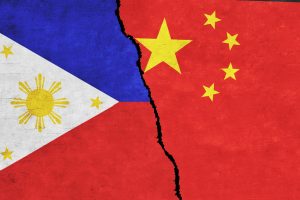Chinese and Philippine vessels have again collided during a standoff in a disputed part of the South China Sea, officials from the two nations said yesterday, trading accusations about who was responsible.
The two sides both confirmed that a collision occurred between China Coast Guard (CCG) vessels and the BRP Bagacay and BRP Cape Engaño, two ships from the Philippine Coast Guard (PCG), in waters close to Sabina Shoal in the Spratly Islands.
The Philippine government yesterday accused the CCG of “unlawful and aggressive maneuvers” that caused “structural damage” to both PCG vessels. In a press briefing, Jonathan Malaya, the assistant director of the National Security Council, said that the collisions occurred at around 3:24 a.m., when the two vessels were en route to the Flat and Nanshan islands, two Philippine-occupied features in the South China Sea.
The Cape Engaño was targeted with “aggressive maneuvers” by a CCG vessel that led to a collision around 23 nautical miles southeast of Sabina Shoal, Malaya said. “This resulted in a collision with the starboard beam of the vessel, creating a hole on the deck with an approximate diameter of five inches,” he added.
Shortly afterwards, BRP Bagacay “was rammed twice on both her port and starboard sides” by another CCG ship, “leading to minor structural damage.” Jay Tarriela, the PCG spokesperson for the West Philippine Sea, told the press briefing this was “the biggest structural damage that we have incurred as a result of the dangerous maneuvers carried out by the Chinese Coast Guard.”
Despite the damage to the two vessels, Malaya said they would continue on their mission to bring supplies to Flat and Nanshan islands, two of the nine Philippine-occupied features in the Spratly Islands.
The Philippine press conference came after a CCG spokesperson said that one of the PCG vessels had ignored repeated warnings and “deliberately collided” with a Chinese vessel in an “unprofessional and dangerous” manner. “The Philippines has repeatedly provoked and caused trouble, violated the temporary arrangements between China and the Philippines,” spokesperson Gan Yu said.
Gan’s mention of “temporary arrangements” was a clear reference to the recent provisional agreement that Manila and Beijing established after a series of clashes at Second Thomas Shoal in the Spratly Islands. Like yesterday’s clash, most of these involved Chinese efforts to prevent the Philippines from resupplying the Philippine garrison stationed in the BRP Sierra Madre, a grounded warship that functions as its outpost on the shoal.
The increased Chinese pressure has been both a cause and an outcome of President Ferdinand Marcos Jr.’s growing security cooperation with the United States and allies such as Japan. These have involved expanded joint maritime patrols, broader U.S. access to military facilities, and, most recently, the creation of a Reciprocal Access Agreement with Japan.
The clash is a sign that despite recent de-escalatory gestures by the two sides, which also included a recent pledge to establish a hotline to better manage frictions in disputed waters, the stay is little more than temporary. Indeed, as some had predicted, now that Beijing’s pressure campaign against Second Thomas Shoal has begun to yield diminishing returns, the locus of the conflict has simply shifted to other parts of the South China Sea.
While the Philippines’ most recent resupply mission to Second Thomas Shoal took place without incident, Chinese Air Force planes last week allegedly dropped flares in the path of the Philippine Air Force plane over Scarborough Shoal, another focus of recent tensions. All of this seems to suggest that a base level of friction will persist in contested waters for the foreseeable future – or at least until Beijing perceives that Manila is willing to adopt a less “confrontational” approach.

































